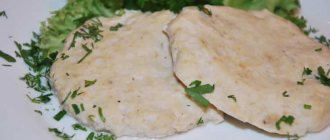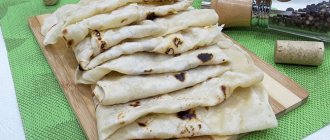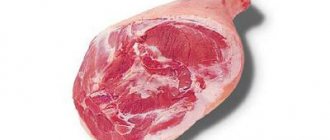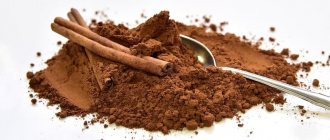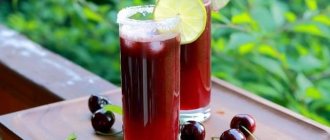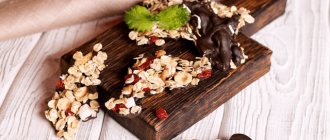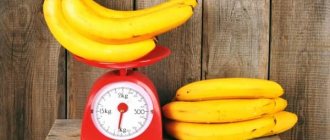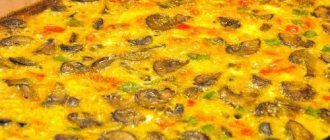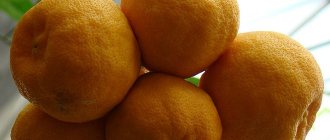Subscribe to topic
Notification by e-mail about replies to a topic during your absence from the forum.
Subscribe to this forum
Notification by e-mail about new topics on the forum during your absence from the forum.
Download/Print theme
Download the theme in various formats or view a printable version of the theme.
Counting calories is one of the most correct schemes for quality weight loss or, conversely, weight gain. To lose weight, as you know, you need to create a calorie deficit, for muscle volume - a surplus. But the calorie content of foods must be determined correctly. And what about raw foods and prepared meals? Let's take a closer look.
Why is it important?
Any calorie table usually shows the calorie content of a raw, unprocessed product per 100 grams. Probably, if we cook 100 grams of oatmeal in water without adding anything, we will get approximately the same calorie content for this entire portion. Only now it will no longer contain 100 grams of weight... But what if the oatmeal is cooked in milk? How to add these “milk” calories?
Many people today use smartphone applications that contain a variety of products - both raw and boiled, different dishes, the same oatmeal with water, milk, and fruit. But how does the author of the application know how much milk you will pour and how much fruit you will put in the porridge? Will you season a fresh vegetable salad with a teaspoon of oil or a tablespoon? And all this significantly changes the calorie content of the finished dish.
Therefore, it is best, of course, to calculate the mass and calorie content of both the raw product and the finished dish from it, and proceed from these indicators. How to do this, and what needs to be taken into account? Let's take a closer look.
As you know, meat significantly decreases in volume when frying, boiling, stewing or baking, in a word, during any temperature treatment. For comparison, take a raw chicken breast and weigh it, then cook it and weigh it again - the difference will be significant. At the same time, a cooked piece of meat will have the same amount of calories as a raw one - the calorie content does not go away. If you take 240-260 grams of chicken fillet, then after cooking they will turn into 140-160 grams, no more. Of course, the weight can vary depending on the cooking method and the duration of the heat treatment (the longer it is, the less the meat will weigh when it comes out). The calories in 240-260 grams of raw breast will be about 280 kcal, and they will also remain in 140-160 grams of finished chicken. It is for this reason that you can calculate the weight of meat both raw and cooked, not forgetting the difference in weight.
Oatmeal, sir! What does a “slimness breakfast” look like?
If you need to lose weight, then it is better to abandon experiments with newfangled diets, and entrust this task to good old oatmeal. And that's why. This healthy product is an element of a healthy diet. It will not only feed you, but also improve your health: strengthen your immune system, get you back on your feet after an illness, maintain normal blood sugar levels, lower cholesterol, make your gastrointestinal tract work well and improve your mood.
Another important quality that oatmeal has for losing weight is its calorie content. For such a nutritious product it is minimal. Constant consumption of this cereal will help kill two birds with one stone - adjust your weight and improve your well-being.
Nuances
Even with this approach, it is unlikely that it will be possible to calculate calorie content exactly to the calorie level. The fact is that each fruit will contain a different amount of sugar, each vegetable will contain a different amount of fiber (which affects the absorption of calories), and cereals can be processed and purified differently, which will also determine their energy value. All tables from cookbooks and even calorie counting apps give only an average result for each product. Use our tips to keep your calorie counting as accurate as possible.
- When preparing porridge with milk, do not forget to add the calorie content of 100 grams of dry cereal to the calorie content of the 100 grams of milk that you poured into it.
- If you cook meat not separately from other ingredients, but, say, in gravy, add the calorie content of sour cream or cream used for it.
- To the energy value of the vegetables you stew, be sure to add the calories of the spoon of oil that you poured into the frying pan.
How much oatmeal is in a glass?
8 level spoons - 100 grams of oatmeal. How much benefit does this have for the body? This serving contains 12.3 g of protein, 6.2 g of fat, 61.8 carbohydrates, as well as a sufficient amount of microelements responsible for the normal psycho-emotional state and beauty of the skin. One standard glass holds 70 g of oatmeal, which is about 5 tablespoons.
Of course, such measurements are approximate, because everyone has their own slides on spoons. But for approximate measurement of portions, it is permissible to use this option for determining the volume. This is certainly better than trying to determine weight by eye or buying scales just to find out how many grams of oatmeal are in a tablespoon.
The phrase “Oatmeal, sir!” even those who have not seen the famous film about Sherlock Holmes know. In fact, this dish “earned” its highest rating in the British Isles, although our ancestors also prepared it. Now we are accustomed to brewing not whole grains, but flakes - they are obtained by flattening oat grains. Range
There are quite a lot of them, but one of the most popular (and familiar to us) brands of
Hercules
gave oatmeal a second name - Hercules.
The product was named this way for a reason: it has been proven that oatmeal helps a growing body gain strength and a weakened body recover. Like other cereals, it contains a large amount of fiber
, which promotes the elimination of toxins and waste - and therefore weight loss.
What determines the calorie content of cereals?
The large number of calories is due to the presence of complex carbohydrates and fatty acids. The maximum content of nutrients, vitamins and microelements is found in those cereals that have undergone minimal processing.
Before sale, some species are steamed, polished and crushed. As a result, they contain less benefits and more calories. So, oatmeal contains 366 kcal per 100 grams, and oatmeal itself has 303.
Nutritionists recommend using predominantly unprocessed grains in the diet. They require more time to prepare and have a higher cost, but the benefits of their use are higher.
Nutritional value and chemical composition
The amazing properties of oatmeal are explained by its “inner content”. A small amount of oatmeal can compensate for a fifth of the daily required amount of protein - which is why it is valued not only by doctors, but also by athletes. If we talk about such useful fiber, 100 grams of flakes will provide almost half of its daily requirement.
In terms of the content of vitamins in oatmeal, the leaders are group B, E and PP, which have a positive effect on the nervous system and ensure healthy skin and hair. Of the minerals in this product, silicon is responsible for beauty - there is one and a half times more of it than the daily norm. Manganese, which is indispensable for hematopoiesis and the growth of new cells, also exceeds its norm. Among other micro- and macroelements in oatmeal, magnesium, phosphorus, cobalt, molybdenum, copper and iron can be distinguished.
Calorie content of different types of cereals in dry form
The most high-calorie cereals are rice, millet and semolina.
Popular white rice is considered unsuitable for dietary nutrition by nutritionists. It is better to use brown one instead.
Buckwheat and oatmeal have the fewest calories. Their energy value barely exceeds the 300 cal threshold.
| Groats | Calorie content per 100 grams |
| Round white rice | 351 |
| Golden rice | 348 |
| Millet | 347 |
| Manna | 337 |
| Brown rice | 336 |
| Corn | 335 |
| Pearl barley | 323 |
| Barley | 321 |
| Barley | 320 |
| Wheat | 315 |
| Buckwheat core | 311 |
| Buckwheat done | 304 |
| Oatmeal | 303 |
Hercules in cooking
The beneficial properties of oat flakes determine the breadth of their use in various dishes. They are used in desserts and appetizers as well as main dishes, including soups.
One of the simplest recipes involves soaking the flakes overnight and then adding grated fruit and chopped nuts. Hercules porridge is a simple but healthy breakfast prepared with water or using fermented milk products (for example, soaking in kefir).
Oatmeal is used as a filling for first courses. Hercules soup is a thick product made with vegetable, meat broth or milk. The cereal can replace an additional filler for meat cutlets, for example, rice or a bun. Raw cutlets or meat are also dipped in crushed flakes to replace traditional breading.
Oats are a frequent guest in the production of sweets. The most famous are cookies with various fillings - chocolate, nuts, dried fruits. In Scandinavian countries, a dessert is prepared from oatmeal, butter and sugar with various additives (nuts, dried berries). The ingredients are mixed into a solid thick mass, formed into balls, baked, then cooled and served. There are several types of desserts in which grated fruit or jam is added.
Calorie content of different types of cereals in finished form
The initial calorie content of dry cereals cannot accurately determine the energy value of the finished dish due to many additional factors.
The product is not consumed raw. Cooking in water causes the grains to swell, become heavier and change consistency. Therefore, 100 grams of porridge with water and without additives will have fewer calories than 100 grams of dry cereal. And adding some products to the dish - for example, milk - will increase the calorie content.
They will also add calories:
The diet menu involves preparing porridge with water and without additives.
Calorie table for boiled cereals
| Groats | Calorie content |
| Rice | 77 |
| Millet | 91 |
| Manna | 82 |
| Corn | 79 |
| Barley | 76 |
| Barley | 107 |
| Wheat | 92 |
| Pearl barley | 108 |
| Buckwheat viscous | 92 |
| Oatmeal | 85 |
Support Group: How do supplements change the calories in oatmeal?
Not everyone likes the taste of oatmeal. To give the porridge brighter and more pleasant notes, additional ingredients are often used. What calorie content will oatmeal have if you add sweet additives to it? In the “company” with honey, 100 g of porridge will contain 117 kcal. If you add this beekeeping product to boiled flakes, you will get 127-129 kcal.
Many people like oatmeal with raisins - its energy value in this combination will increase to 131 kcal. Flakes with raisins will contain 161-167 kcal. If you really want to enjoy sweet porridge, but are afraid of ruining your waistline, then instead of sugar, honey or raisins it is better to take pumpkin. This delicacy will bring only 63 kcal. If you take cereal instead of cereal, the calorie content will be slightly higher - 91-94 kcal.
If you want to lose weight, then it is better not to cook the porridge, but pour boiling water over it and let it brew. This will have a positive effect on the calorie content of the dish, since for steamed oatmeal it will be slightly lower than for boiled oatmeal - about 85 kcal. But such a product will retain much more useful substances.
Minute oatmeal porridge is not for those who strive to be slim. Want to know how many calories are in a bowl of oatmeal from a bag? Fast food products are a real storehouse of calories. In instant porridge (per 100 g) there are 5 times more of them than in regular porridge - 350 kcal!
Many housewives prefer to cook in a slow cooker. How many calories are in water-based oatmeal cooked with this kitchen aid? A 100-gram serving will contain 114 kcal. Porridge can also be cooked in the microwave. In terms of calories, it will be almost the same - 110 kcal.
Cereal diet
Nutritionists have developed a special diet, which is called cereal or grain.
It lasts 7 days. You can choose one type of cereal and eat only that, or you can change the cereal daily. In both options, the body receives the necessary amount of nutrients and gets rid of extra pounds.
- Cook exclusively with water.
- Eliminate additives in the form of salt, sugar, as well as possible ways to affect taste.
- Drink at least 2 liters of water per day. Additionally, green tea is also allowed without sugar.
It is optimal to use buckwheat, oats, millet, all types of rice except white, and red lentils. Cereals and semolina porridge are not suitable. As an exception, you can add 1 teaspoon of honey to your morning serving. You can consume 100 ml of low-fat kefir, 1 apple and 100 ml of vegetable broth.
The porridge is prepared a little differently than usual. Soak a glass of cereal overnight. In the morning, drain the water and add fresh water. Boil the swollen grains for 4-6 minutes and you can eat. The resulting portion is the daily norm, which must be divided into 4-5 equal parts.
In one week, using this method of nutrition, waste and toxins will leave the body, sugar levels will normalize, cholesterol levels will decrease, and metabolic processes will be activated. The body will receive a strong boost of energy and a push to function properly.
You need to get rid of grains in stages. Every 2-3 days, add new fruits and vegetables, then add meat. At the same time, it is recommended to return a small amount of salt to the diet. It does not allow fluid to be quickly removed from the body and thereby helps maintain water balance.
Uses of oatmeal
The described cereal is used not only in cooking. It is widely used for cosmetic purposes. It was also adopted by folk healers. Oatmeal is one of the components of many folk recipes used to eliminate or prevent various health problems. In traditional medicine, it is recommended in the diet for people during the postoperative period and for diseases of the digestive tract.
In cosmetology
The active substances present in oats can have a number of beneficial effects on the skin. They exfoliate dead cells, renew, nourish, soften them, give them elasticity and smoothness. It has been proven that the product can accelerate wound healing, prevent the appearance of wrinkles, and retain moisture. Oats are included in many scrubs, soaps, shampoos, tonics, milks, and creams designed to rejuvenate and slow down the aging process. It is used in decorative and medicinal cosmetics.
It is recommended to use oatmeal and flakes when carrying out cosmetic procedures at home. These products are included in cleansing, anti-inflammatory, moisturizing, refreshing and nourishing masks and scrubs. They are also used to get rid of oily shine and acne.
Oatmeal is recommended for daily washes . This procedure is suitable for various skins, including problematic ones. In addition to the face, the product in question is also used to care for hands and nail plates. It is added during the preparation of baths, nourishing and moisturizing masks.
In medicine
In folk medicine, the described cereal is recommended to be used for many diseases. So, for gout, it is recommended to reduce uric acid in the body and improve well-being. It is recommended to include oatmeal in a menu consisting of dietary dishes. As a result of a long-term diet, it is possible to restore the disturbed balance of substances.
For acute colitis, oatmeal is also recommended for inclusion in the first days of diet. For gastritis and pancreatitis, you can only consume the boiled product. This is the only way to eliminate inflammation and improve digestion.
How to store
You can store oatmeal in different ways. Many people use cellophane bags for these purposes; they have a shelf life of 1 year. Can be stored in cardboard packaging for no more than 4 months.
The table contains methods for storing this cereal.
| Container type | pros | Minuses |
| Metal | Looks high quality and stylish | Rust forms over time |
| Plastic | Very light, do not put a strong load on shelves and cabinets | Need to change jars frequently |
| Ceramic | Beautiful design, roomy, low cost | The container is heavy |
| Glass | Stylish look, light, roomy, inexpensive | None |
Oatmeal is a valuable product that must be included in the menu of adults and children. It has a beneficial effect on health.
But it is still necessary to use it correctly. You shouldn’t eat it all the time; it’s better to alternate it with other cereals. The best time to use it is in the morning, namely breakfast.
Harm and contraindications to eating oatmeal
The rich composition of oatmeal in some cases can provoke an exacerbation of existing diseases, namely:
- Celiac disease is an intolerance to the vegetable protein of cereals (gluten, that is, glue) or an allergic reaction to it. This is due to its ability to disrupt intestinal absorption, causing a toxic effect on the mucous membrane. This reaction can trigger food allergies, in particular to cow's milk proteins.
- Diabetes mellitus (types 1-2) due to the threat of an increase in the glycemic index when consuming instant oatmeal. It is this that is deprived of healing coarse fibers as a result of the industrial multi-stage processing of oatmeal. This phenomenon is also explained by the high content of starch in it, which is converted into sugar during the accumulation process. At the same time, flakes that are not subject to long-term processing and retain inulin in their composition do not pose a danger to diabetics.
- Excessive consumption of oatmeal is fraught with demineralization of the body due to the danger of increasing the volume of phytic acid. This is an obstacle to the absorption of calcium, enhanced by its removal from bone organs, which poses a danger for people predisposed to osteoporosis.
- Kidney failure . One of its manifestations is gout, which can result from the destruction of purine built into plant/human genes. Under certain conditions, this substance in this case forms an excess amount of uric acid in the joints, leading to the appearance of gouty arthritis syndrome.
Kinds
There are several types of oatmeal, depending on the quality of the grains and the number of operations performed in the production of the cereal:
- "Extra".
- "Hercules".
- Petal oat flakes.
Kinds
The last two components of the list are made from premium grains. The “Extra” category belongs to the first class of oats.
Subspecies of this category are:
- Whole grain flakes.
- Flakes of cut grains.
- The flakes are quick-cooking.
According to nutritionists, thin flakes are digested faster, but those closer to whole grains provide a longer period of satiety.
